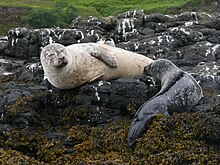Fauna Skotlandia

Fauna Skotlandia secara umum khas dari barat laut bagian Eropa dari Alam paleartik, meskipun beberapa mamalia negara yang lebih besar diburu hingga punah di masa bersejarah dan aktivitas manusia juga telah menyebabkan berbagai spesies satwa liar diperkenalkan. Lingkungan Skotlandia yang beragam sedang mendukung 62 spesies mamalia liar, termasuk populasi kucing liar, jumlah penting abu-abu dan anjing laut pelabuhan dan koloni lumba-lumba hidung botol paling utara di dunia.[1][2][3]
Banyak populasi burung tegalan, termasuk ayam kaki-kasar hitam biasa dan ayam-salju dedalu merah tinggal di sini, dan negara ini memiliki sarang yang signifikan secara internasional untuk burung laut semacam itu sebagai gannet utara.[4] elang emas telah menjadi ikon nasional,[5] dan elang ekor putih dan elang tiram baru-baru ini menjajah kembali daratan. Scottish crossbill adalah satu-satunya endemik vertebrata spesies di Inggris Raya.[6][7][8]
Laut Skotlandia termasuk yang paling produktif secara biologis di dunia; diperkirakan jumlah total spesies laut Skotlandia melebihi 40.000.[9] Darwin Mounds adalah area penting terumbu karang air dingin laut dalam yang ditemukan pada tahun 1998. Di pedalaman, hampir 400 populasi salmon Atlantik yang berbeda secara genetik hidup di sungai [10] Dari 42 spesies ikan ditemukan di perairan tawar negara itu, setengahnya telah tiba melalui kolonisasi alami dan setengahnya lagi oleh introduksi manusia.
Hanya enam amfibi dan empat reptil darat yang asli Skotlandia, tetapi banyak spesies invertebrata yang tinggal di sana yang langka di Britania Raya (UK).[11] Diperkirakan 14.000 spesies serangga, termasuk lebah dan kupu-kupu langka yang dilindungi oleh rencana aksi konservasi, menghuni Skotlandia. Badan-badan Konservasi di Inggris Raya khawatir bahwa perubahan iklim, terutama efek potensialnya pada dataran tinggi gunung dan kehidupan laut, mengancam sebagian besar fauna di Skotlandia .[12]
Referensi
[sunting | sunting sumber]- ^ Thompson, P.M.; Corkrey, R.; Lusseau, D.; Lusseau, S.M.; Quick, N.; Durban, J.W.; Parsons, K.M.; Hammond, P.S. (2006). "An assessment of the current condition of the Moray Firth bottlenose dolphin population". Scottish Natural Heritage Commissioned Report. Perth (175).
- ^ Matthews (1968) p. 254.
- ^ "Mammals". Scottish Natural Heritage. Diarsipkan dari versi asli tanggal 30 December 2006. Diakses tanggal 1 January 2007.
- ^ Fraser Darling and Boyd (1969) hlm. 7, 98–102.
- ^ Benvie (1994) p. 12.
- ^ In the past, this claim has been made on behalf of other species such as the red grouse (now considered to be a sub-species of willow ptarmigan) and Irish stoat (Mustela erminea hibernica), also now considered to be a sub-species of Cerpelai ekor-pendek. Loxia scotica's position as a true species is a matter of debate but the current consensus is that it does have this status (see for example Miles and Jackman (1991) pp. 21–30 and Benvie (2004) p. 55.) The position of the freshwater fish the vendace Coregonus vandesius is disputed, with many authorities considering it to be a synonym of Coregonus albula.
- ^ Adams, William Mark (2003) Future Nature Diarsipkan 2023-07-18 di Wayback Machine.. British Association of Nature Conservationists p. 30. Retrieved 14 July 2009. This source lists the UK's endemic species as being "14 lichens, 14 bryophytes, 1 fern, 21 higher plants, 16 invertebrates and 1 vertebrate (the Scottish crossbill)."
- ^ Perhaps because endemic vertebrates are all but absent from the UK neither SNH nor JNCC appear to provide a definitive "list" but it is clear that the Scottish crossbill is the only endemic bird, (Gooders (1994) p. 273. and "Scottish Crossbill: Loxia Scotica" Diarsipkan 2011-02-04 di Wayback Machine. (pdf) JNCC. Retrieved 7 July 2009.) and that there are no endemic freshwater fish (Maitland, P. and Lyle A.A. (1996) "Threatened freshwater fishes of Great Britain" Diarsipkan 2023-07-18 di Wayback Machine. in Kirchofer, A. and Hefti, D. (1996) Conservation of Endangered Freshwater Fish in Europe. Basel. Birkhauser.) or mammals ("The British Mammals list" Diarsipkan 28 July 2011 di Wayback Machine. ppne.co.uk. Retrieved 7 July 2009.) in Britain. There are too few amphibians and reptiles native to the UK for there to be any doubt that no endemic species exist. The position is implied, although not stated by SNH in their Information and Advisory Note Number 49 "Priority species in Scotland: animals" Diarsipkan 9 November 2016 di Wayback Machine. Retrieved 7 July 2009. See also Myers, Norman (2003) "Conservation of Biodiversity: How are We Doing?" Diarsipkan 16 July 2011 di Wayback Machine. (pdf) The Environmentalist 23 pp. 9–15. Retrieved 7 July 2009. This publication confirms there is only one "endemic non-fish vertebrate species" in the British Isles, although it fails to identify the species concerned.
- ^ "Inshore Fisheries in Scotland". The Scottish Government. Diarsipkan dari versi asli tanggal 7 June 2011. Diakses tanggal 24 August 2008.
- ^ "Protecting and Promoting Scotland's Freshwater Fish and Fisheries". Scottish Executive. Diarsipkan dari versi asli tanggal 29 August 2009. Diakses tanggal 13 January 2007.
- ^ Miles dan Jackman (1991) hal. 48.
- ^ See for example Johnston, I. (29 November 2006) "Sea change as plankton head north'". Edinburgh. The Scotsman. This report quotes James Lovelock's concern that global warming will "kill billions" of people over the coming century.
Pranala luar
[sunting | sunting sumber]- Scottish Natural Heritage
- Forestry Commission Scotland Diarsipkan 17 December 2010 di Wayback Machine.
- Joint Nature Conservation Committee Diarsipkan 2020-08-13 di Wayback Machine.
- Scottish Wildlife Trust Diarsipkan 2010-03-16 di Wayback Machine.
- Royal Zoological Society of Scotland Diarsipkan 2012-07-26 di Wayback Machine.
- Scotland's National Nature Reserves Diarsipkan 2023-06-05 di Wayback Machine.
- Royal Society for the Protection of Birds Diarsipkan 2008-09-02 di Wayback Machine.
- Scottish Seabird Centre Diarsipkan 2020-11-17 di Wayback Machine.
- Cairngorms National Park Authority Diarsipkan 2015-03-23 di Wayback Machine.
- Loch Lomond & The Trossachs National Park Authority Diarsipkan 2020-11-16 di Wayback Machine.
- John Muir Trust Diarsipkan 2008-08-29 di Wayback Machine.
- Trees for Life Diarsipkan 2023-07-10 di Wayback Machine.
- Butterfly Conservation Scotland
- Introduction To Britain's Lost Wildwood Diarsipkan 2012-10-23 di Wayback Machine.
- Scottish Wildcat Association Diarsipkan 2012-09-17 di Wayback Machine.
